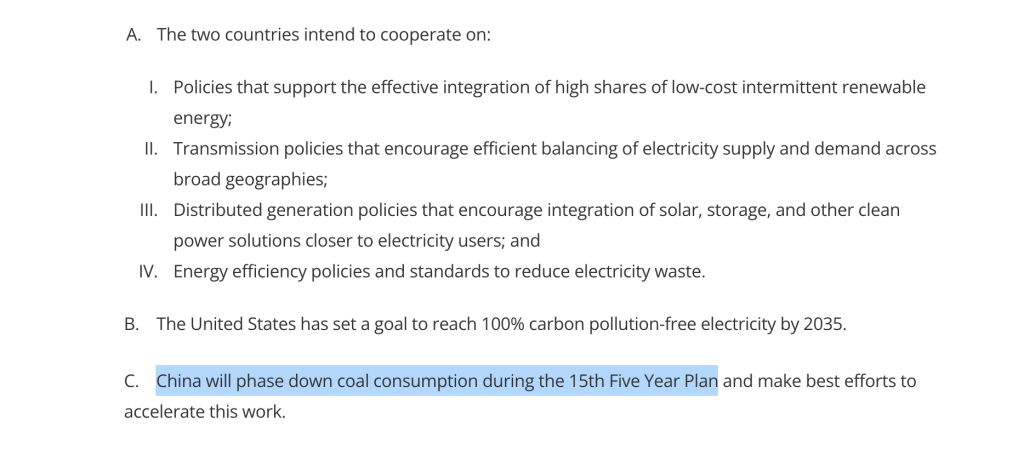Reactions to the Glasgow Climate Pact have been mixed. Whereas some have labelled it a failure, mainly due to the weak wording on coal and the failure of high-income countries to commit new money to loss and damage, others have sought to highlight its successes.
After all, the Paris Agreement is now complete, after 6 years of negotiations on the rules concerning carbon markets and transparency; emissions-reduction targets for 2030 will have to be updated by next year, rather than in 2025 as per the Paris agreement; the need to cut emissions by at least 45% by 2030 has been formally recognised in an effort to “keep 1.5C alive”; the phase-down/out of coal and fossil fuel subsidies was included in the final text; and a clear target has been set to double finance for adaptation by 2025.
I am incredibly grateful to everyone who has helped get us here today in Glasgow
But this is a fragile win
We have to continue to work together to kept 1.5 alive
Read my full statement here on the outcomes of #COP26: https://t.co/SHP22t3bDc pic.twitter.com/8xSCZA7I10— Alok Sharma (@AlokSharma_RDG) November 13, 2021
More than a success or failure COP26 was one more step in a gradual and incremental process that is changing the way countries and people look at climate change whilst at the same time putting science increasingly at the centre of decision-making processes.
In the first part of its sixth assessment report, published in August and described as “code red for humanity”, the IPCC had shown that the world is likely to hit 1.5C by the early 2030s. That these scientific findings formed the backbone of the COP26 is especially significant if put in the context of just three years ago at COP24 in Katowice, where Saudi Arabia and the US had stifled efforts to “welcome” the findings of the IPCC special report on 1.5C.
In fact, scientific evidence led parties entering negotiations to recognise that the Paris agreement will not deliver decarbonisation at a sufficient rate to meet its goals, national commitments to date are not sufficient to “keep 1.5 alive”. The Pact even puts the IPCC’s findings in the spotlight, with the first subheading “science and urgency”, which “recognises” that the impacts of climate change will be “much lower” at 1.5C compared with 2C and “resolves to pursue efforts” to stay under the lower limit.
What was actually agreed in Glasgow?
Here's the breakdown of what made it into the final deal #COP26 https://t.co/5vWXzRo49Y
— Chloé Farand (@ChloeFarand) November 15, 2021
From this starting point, delegates have agreed to update their national commitments within the next twelve months, instead of by 2025 as initially agreed upon in Paris, and come up with pledges for 2030 that are in line with what research tells us is necessary to limit warming. How to do this is largely what was discussed in Glasgow.
The Glasgow Climate Pact
Week one of negotiations started with progress across a variety of themes, leading to deals on deforestation, finance, methane and more. This was then followed in week two by negotiations over the rules governing carbon credits between countries, transparency, finance to support low-income countries decarbonise and adapt, culminating with the surprising China-USA joint declaration, which although positive also gave a brief glimpse into the emerging issue concerning the wording around a transition away from fossil fuels and more specifically coal.
After these two weeks of negotiations, parties reached a consensus around the Glasgow Climate Pact which recognises that “limiting global warming to 1.5C requires rapid, deep and sustained reductions in global greenhouse gas emissions”, which implies reducing emissions by 45% by 2030 and net zero by 2050, compared to 2010 levels.
Furthermore, the Pact takes more steps to explain how this will be achieved compared to the Paris agreement. One of the main ways in which it aims to reach this objective is by calling for more clean energy and “efforts towards the phase-down of unabated coal power and phase-out of inefficient fossil fuel subsidies”.

The fact that there is a direct reference to coal is not to be underestimated, after all, it is a first for the process. In fact, this very sentence was one of the most debated parts of the pact and reflects the fact that many big emerging economies rely heavily on the fuel.
Despite the weaker language than the original “phase-out, Laurie van der Burg from Oil Change International told Climate Home News the reference to fossil fuels was an “important symbolic breakthrough”.
“This is a foot in the door for an urgently needed conversation about winding down coal, oil, and gas and ending all subsidies,” she said.
It is the first time that India has explicitly addressed the question of a coal exit, according to Chris Littlecott, associate director of thinktank E3G. He noted that major coal exporters, including Australia, Indonesia and Colombia, had accepted the language of coal phaseout.
Furthermore, the China-USA joint declaration contained the first reference to “phase-down” of coal power, which was then used by India and forced into the final version of the Glasgow Climate Pact to the disappointment of many.

This shows that although India is getting much of the stick, the term had already been in circulation and observers point to its early endorsement by countries such as China and the USA.
What lies ahead
“The meaning of COP is shifting,” said Naoyuki Yamagishi, energy and climate director for WWF Japan. He told Carbon Brief: “It is no longer just about formal decisions. We’re seeing a changing phase of the Paris Agreement from rulemaking to implementation.”
Although the text left many disappointed over a lack of “balance” between the strength of language and action on emissions cuts, relative to finance or loss and damage, the fact that it was agreed at all can be considered a victory for the COP process.
George Monbiot, writing for The Guardian, expressed his dismay at the weakened outcomes of the COP26, although he also left room for hope by highlighting how “small interventions by government could trigger cascading change. This has already happened in Norway, where a change in taxes made electric vehicles cheaper than fossil-fuel cars. This flipped the system almost overnight: now more than 50% of the nation’s new car sales are electric, and petrol models are heading for extinction.”
To “keep 1.5ºC alive”, as Britain, the host of the conference, said it had to do, required a dramatic further acceleration of the process defined in Paris. The COP26 has delivered on this promise by changing timetables, tweaking financing arrangements and allowing for greater multilateralism. Whether this will be sufficient is still to be seen. In the words of Alok Sharma, “The hard work starts now”.






